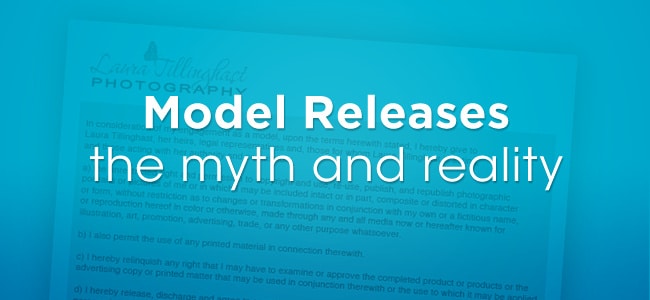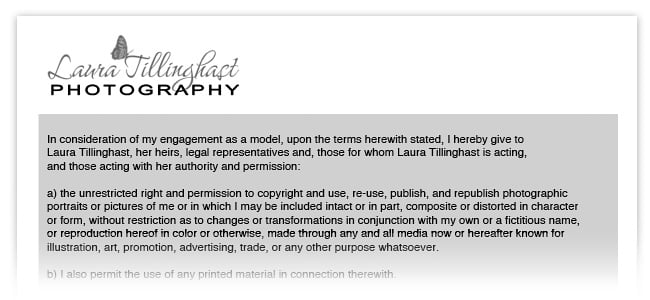Photographer’s Corner: A practical guide to model releases and covering your behind
September 15th, 2013
Whether you are a commercial photographer like myself, or if you shoot weddings, events, or stock images, or any type of portrait-based photography where working with human subjects is the norm, it is best to have a good model release policy in place.
Before you get up in arms over this statement, let’s be clear. A model release is not needed to take or sell photographs. A model release is a way to protect yourself and your business from possible misunderstandings. In the event that images of a subject are used in a manner that the subject is not okay with, it’s important to have your bases covered with permissions and liability. The laws regarding usage and permissions are complicated, vary by location, and have a lot of gray areas. Due to this the use of releases has become a way for photographers to be proactive. At the very least, a model release gets a conversation started between photographer and subject about how images will be used. The article below outlines my personal opinions and experiences in today’s industry.

A model release is a legal form between a photographer and the person they are photographing. This form gives permission from the subject to the photographer to use the images for specific applications and waives the right to privacy. Applications can mean anything from advertising and print media to commercial websites and blogs.
The first consideration when determining if you want to use a model release is to think about how you plan to use the images. Will the images be sold to or used by a third party? Will you be offering the images for sale as stock or fine art? Are the images for the model themselves, as with portraits and event images? Or will you be using the images for your portfolio alone?
A model release is common practice any time a commercial application is the end goal. Commercial applications are generally defined as “use that is intended to promote, endorse or sell a product.”
The most important consideration for me personally is whether I will be making a profit. If I am making money from a photo shoot I always make sure to have a model release in place. For any commercial application I am always very clear with the model or subject on exactly how the images may be used. I outline the same terms in my model release so that there is no mystery or surprises. This can go a long way if there are any disputes down the road.
If you were to skip this step and sell images without a model release, then you may be open to liability if the model (or the agency that represents the model) has a problem with the use of the images. The laws on this vary by location and genre so it is important to educate yourself on what is expected in your corner of the industry, wherever you work and reside.

If you are commissioned to shoot a job for a client, 9 times out of 10 they will handle the model release themselves, since they know what applications they need to cover. Or they may decide that they do not need this. It’s important to keep in mind that even though the photographer produces an image, the liability of its usage resides with the company “publishing” the image.
If you are shooting images on your own but the goal is to ultimately have them purchased for commercial use (like stock), you may want to get a model release signed from the outset. I always have a model release signed the day of the shoot so that I don’t have to worry about tracking the model down later. Keep in mind that many stock agencies require releases, but the actual release terms vary greatly.
As I mentioned before, I always make sure that a release is in place whenever I make any type of profit. If I am shooting for any commercial purposes then I always make sure that the model is also compensated at least in a small amount. Model releases are a legal form but they become more of a contract when money changes hands. For my own model releases I always list the fee that is being paid to the model. This way I have it for my reference and the model understands when signing the document that the fee is what they can expect as a total for compensation.
As an event or portrait photographer you want to think beyond the immediate purpose of the photos. A wedding photographer’s clients likely will not need the images beyond personal usage. However, you may want to use the images in your portfolio, on your blog, or to promote yourself on social media sites. You may even want to enter your best images in photo contests or license to a third party at some point. Most wedding, engagement, and portrait photographers have all their clients sign a general-use model release. The release lists the possible usages and also excuses the photographer from having to gain permission or pay royalties or fees in relation to later usage.

A release is not always necessary when shooting solely for a photography portfolio or when working with a subject who is also building a portfolio. A good-faith agreement between the photographer and model that the images will only be used for portfolio and self-promotion is usually sufficient. I generally follow this guideline for images I shoot for my portfolio. Although recently a company asked if they could license an image from my portfolio to be used in a print ad. I had shot the image about three years before and did not have a model release in place. I tried to reach the model to get permission but was never able to get in touch with her. Even though this type of usage was never discussed with the model, I could have sold the image anyway. But I did not feel right about it without the model’s permission. In the end the company chose another image at my suggestion, and for that one I was covered. This could very easily have been an opportunity lost so I have since started using model releases more judiciously.
Another consideration to keep in mind is the age of the subject. Whenever a model is under the age of 18, I get a model release signed by a parent or legal guardian. No exceptions. Legally an underage model cannot enter into an agreement of usage without parental consent. Even if I am not sure how I will end up using the images I cover my backside with parental permission and signature to be on the safe side.
It is also important to consider that with photographic images being readily available via the Internet, it is not inconceivable that one of your images may get into the wrong hands and be used without your consent. As a photographer you are the copyright holder of your images, but having a model release in place as well can go a long way in releasing you from liability. Over the years I have heard a number of spine-tingling horror stories of lawsuits and situations that left photographers with their finances and reputations in ruins. I have also experienced my share of image theft, so I always err on the side of caution when it comes to legal liability.

There are occasions when a model release is not needed. If you plan to use your images for editorial purposes only then a model release is usually not required. Editorial usage refers to images used in conjunction with a news article, story, or text. Most commonly this includes magazines, books, newspapers, and features. The location where a photograph is taken is also important. If you are photographing people in a public place like a park or open event, such as a concert, then there is no expectation of privacy. Again though, if commercial application comes into play, then a different set of rules apply, as we covered above.
Many photojournalists and documentary photographers do not plan to use their images for commercial applications, and many times it is not possible for them to obtain releases for every subject in a photo. It is also not necessary to worry about releases for editorial use if the subjects in the images are not recognizable. If a subject’s face is obscured or not showing in an image then a release is not as important.
For fine artists the use of releases is more complicated. As a general rule images that are used only for self-promotion and fine art do not require a release. I am not sure how this is done abroad, but in the United States the Constitutional First Amendment protects artistic exhibitions and publications as a form of free speech. For fine artists, releases are more commonly used as contracts for the purpose of releasing the artist from needing to pay future royalties to an artistic subject. Different states have different definitions of what constitutes self-promotion versus advertisements. When in doubt research what the laws are in your location and err on the side of caution. It is also worth noting that some fine art galleries do require releases when artwork is on display and ultimately for sale to customers.

As with photographs of a human subject, a release may also be needed for photographs of locations that are clearly recognizable. For example, if you plan to photograph portraits in front of a local business for use in your portfolio and offer the images for sale as stock, or sell them for use in a brochure or website image, then it’s important to get a property release signed by the owner of the business. As with a human subjects the release waives any right to privacy regarding a location, be it a personal residence or place of business.
To make things even more complicated, some locations are trademarked, which definitely effects how you can use and distribute an image. The Empire State Building falls into this category. While you are well within your rights to sell an image of the Empire State Building as fine art, you would most likely need a property release to sell the same image as a stock photo.

Many photography organizations like PPA, ASMP and WPPI offer guidance regarding model releases and can be very helpful in determining the laws in your geographic region. I personally swear by the book Business and Legal Forms for Photographers by Tad Crawford and use the accompanying DVD with preloaded and customizable forms quite often. Additionally, there are many websites that offer sample model releases, and there is even an app for your smart phone or tablet to make the process easy.
Keep in mind that the advice in this article is based on my own experiences over many years in the industry. I have been lucky to assist and learn from some great photographers, and ultimately I run my business the way I have seen other successful professionals run theirs. It’s a good idea to have as much communication between photographer and subject as possible. I have never heard of anyone being sued over getting a model release signed, but I sure have heard stories about lawsuits that occurred when there was no release.
If you deal with the challenge of model releases in your business, I would love to hear about it. Whether your approach is the opposite from mine or just a slight variation, please leave a comment in the section below. Let’s keep the conversation going. Together we can prevent fellow photographers from becoming a cautionary tale.


Laura Tillinghast started making art at a young age, discovering photography as her true passion in college. From that point on she has never put her camera down. Shooting primarily advertising and editorial content, you never know what you will find in front of her lens. Also an educator, Laura holds a series of popular photo workshops that focus on the fundamentals of lighting. Check out her online portfolio here: https://lauratillinghast.com/



